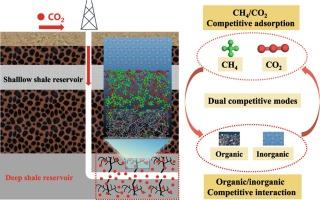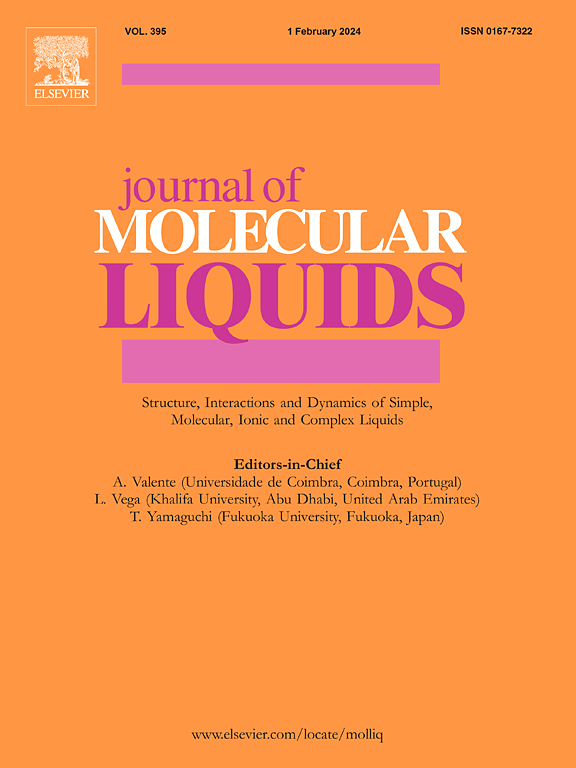页岩纳米复合材料中 CH4/CO2 双重竞争模式的分子洞察:对深层页岩储层中二氧化碳封存和提高天然气采收率的影响
IF 5.2
2区 化学
Q2 CHEMISTRY, PHYSICAL
引用次数: 0
摘要
二氧化碳强化页岩气采收在提高吸附气采收率和促进二氧化碳地质封存方面具有巨大潜力。然而,在深层页岩气藏中进行二氧化碳强化采气的可行性和微观机理仍有待阐明。本研究构建了一个石英-角质狭缝模型来表示深层页岩气藏的页岩复合纳米孔隙。利用大规范蒙特卡洛和分子动力学方法,研究了具有代表性的深层页岩储层高温高压条件下 CH4、CO2 及其混合物的吸附和扩散行为。分析了温度、压力和孔径大小的影响因素。通过考虑不同岩石成分之间的竞争性相互作用和量化各种气体储存状态,揭示了深层页岩纳米孔隙中 CH4/CO2 竞争性吸附的微观机制。结果表明,在深层页岩储层条件下,CO2 的吸附能力大于 CH4。在小的页岩孔隙中,CO2 对 CH4 的置换效率更高。与 CH4 相比,高温对 CO2 的吸附有更明显的负面影响。与中深层页岩储层相比,深层页岩储层的纳米孔隙中游离的 CH4/CO2 状态比例更高。石英对 CH4/CO2 的亲和力大于角质,但角质具有更大的比表面积,因此单位体积的吸附能力更高。在各种储存状态下,CH4/CO2 扩散能力的层次结构如下:溶解在角质层基质中的气体;吸附在石英表面的气体;吸附在角质层表面的气体;游离在孔隙中心的气体。这项研究加深了人们对深层页岩气藏中二氧化碳强化采气的理解。本文章由计算机程序翻译,如有差异,请以英文原文为准。

Molecular insights into dual competitive modes of CH4/CO2 in shale nanocomposites: Implications for CO2 sequestration and enhanced gas recovery in deep shale reservoirs
CO2 enhanced shale gas recovery has significant potential for improving the recovery rate of adsorbed gas and facilitating the geological sequestration of CO2. Nevertheless, the feasibility and microscopic mechanisms of CO2 enhanced gas recovery in deep shale gas reservoirs remain to be elucidated. In this study, a quartz-kerogen slit model was constructed to represent the shale composite nanopores of deep shale reservoirs. Utilizing the grand canonical Monte Carlo and molecular dynamics methods, the adsorption and diffusion behavior of CH4, CO2 and their mixtures was investigated under high-temperature and high-pressure conditions representative of deep shale reservoirs. The influences of temperature, pressure and aperture size were analyzed. The microscopic mechanisms governing the CH4/CO2 competitive adsorption in deep shale nanopores were uncovered by considering the competitive interactions between different rock constituents and quantifying the various gas storage states. The results show that the adsorption capacity of CO2 is greater than that of CH4 under the deep shale reservoir conditions. The replacement efficiency of CH4 by CO2 is higher in small shale pores. High temperature has a more significant negative impact on the adsorption of CO2 compared to that of CH4. Compared to mid-deep shale reservoirs, the nanopores of deep shale reservoirs have a higher proportion of free CH4/CO2 states. Quartz exhibits greater affinity for CH4/CO2 than kerogen, but kerogen possesses a larger specific surface area, resulting in a higher adsorption capacity per unit volume. The hierarchy of CH4/CO2 diffusion capacity in various storage states is as follows: dissolved gas in the kerogen matrix < adsorbed gas on the quartz surface < adsorbed gas on the kerogen surface < free gas in the pore center. This study improves the understanding of CO2 enhanced gas recovery in deep shale gas reservoirs.
求助全文
通过发布文献求助,成功后即可免费获取论文全文。
去求助
来源期刊

Journal of Molecular Liquids
化学-物理:原子、分子和化学物理
CiteScore
10.30
自引率
16.70%
发文量
2597
审稿时长
78 days
期刊介绍:
The journal includes papers in the following areas:
– Simple organic liquids and mixtures
– Ionic liquids
– Surfactant solutions (including micelles and vesicles) and liquid interfaces
– Colloidal solutions and nanoparticles
– Thermotropic and lyotropic liquid crystals
– Ferrofluids
– Water, aqueous solutions and other hydrogen-bonded liquids
– Lubricants, polymer solutions and melts
– Molten metals and salts
– Phase transitions and critical phenomena in liquids and confined fluids
– Self assembly in complex liquids.– Biomolecules in solution
The emphasis is on the molecular (or microscopic) understanding of particular liquids or liquid systems, especially concerning structure, dynamics and intermolecular forces. The experimental techniques used may include:
– Conventional spectroscopy (mid-IR and far-IR, Raman, NMR, etc.)
– Non-linear optics and time resolved spectroscopy (psec, fsec, asec, ISRS, etc.)
– Light scattering (Rayleigh, Brillouin, PCS, etc.)
– Dielectric relaxation
– X-ray and neutron scattering and diffraction.
Experimental studies, computer simulations (MD or MC) and analytical theory will be considered for publication; papers just reporting experimental results that do not contribute to the understanding of the fundamentals of molecular and ionic liquids will not be accepted. Only papers of a non-routine nature and advancing the field will be considered for publication.
 求助内容:
求助内容: 应助结果提醒方式:
应助结果提醒方式:


